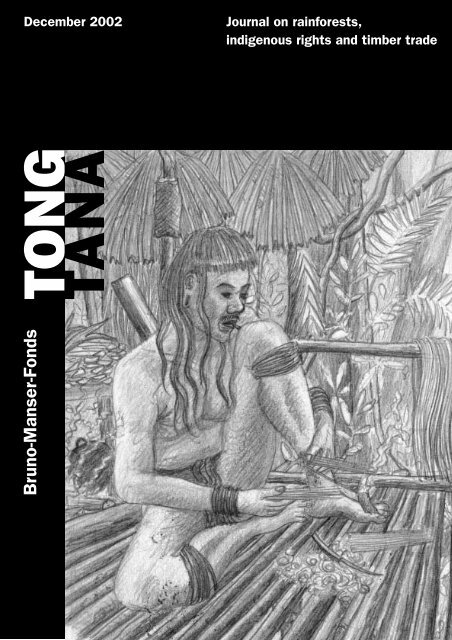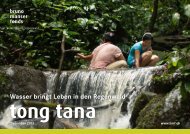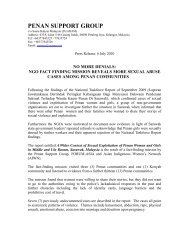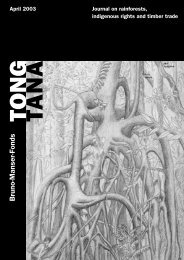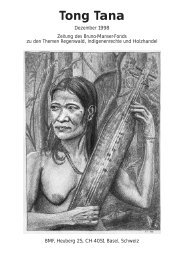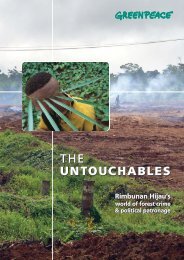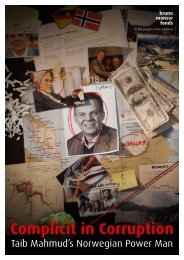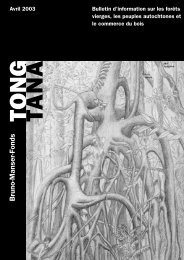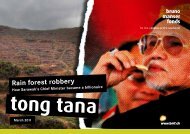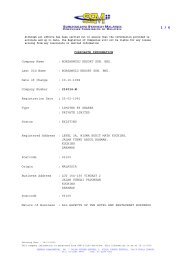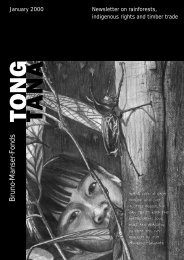PDF - Bruno Manser Fonds
PDF - Bruno Manser Fonds
PDF - Bruno Manser Fonds
Create successful ePaper yourself
Turn your PDF publications into a flip-book with our unique Google optimized e-Paper software.
December 2002<br />
Journal on rainforests,<br />
indigenous rights and timber trade<br />
<strong>Bruno</strong>-<strong>Manser</strong>-<strong>Fonds</strong>
Editorial<br />
Post modern society defines well being through the<br />
power to purchase and consume. Ultimativly it demands<br />
an ever increasing production of new consumer<br />
goods to satisfy its desires – while simultaneously<br />
shutting down its own production centres. Lacking a<br />
moral sense, post modern society thereby condemns<br />
a greater part of mankind to live lives without future<br />
prospects an in powerlessness. Relocation of production<br />
centres to the so-called “developing countries” literally<br />
prevents a healthy, organic – i.e. sustainable –<br />
development in the societies of these countries. If<br />
post modern society cannot push through its interests<br />
via contracts, sanctions and blackmail then it has no<br />
scruples to use violence to this end, as shows the<br />
present war over the last oil reserves so essential to<br />
the system.<br />
A period of economic recession, like the one we are<br />
currently experiencing, does have the positive side effect<br />
of exposing the unholy system of inter-dependencies<br />
and corruption – the “great” achievements of civilisation<br />
turn out to be one gigantic pomposity.<br />
On November 19 th , 2002, 247 Indonesians were escorted<br />
by the police of Sarawak to Kalimantan. These<br />
workers suddenly found themselves jobless after the<br />
foreign owner of 3 bankrupt plywood and furniture factories<br />
ran away. The Indonesians had been working for<br />
years in the factories, earning monthly salaries<br />
amounting to 100 US dollars.<br />
Many of Sarawak’s indigenous people still resist taking<br />
up work under such bad conditions. Still, but for how<br />
much longer? Every day their own sustainable economic<br />
system is being destroyed with political blessings,<br />
international financing by global companies, and<br />
cheap day labour. Soon they, who have lived independently<br />
for centuries and millennia will have no other op-<br />
During another unsuccessful search for <strong>Bruno</strong>,<br />
organised by Erich <strong>Manser</strong> in August 2002, ...<br />
... a commemorative<br />
plaque in Penan<br />
language was left<br />
on Batu Lawi: Your<br />
love is living – we will<br />
never forget you!<br />
tion but to lay aside their self-respect, their culture and<br />
their knowledge and to sell themselves as paid slaves.<br />
Unless the negative economic situation continues. For<br />
the Penan and many other indigenous peoples the<br />
present economic depression is a blessing. The present<br />
lack in demand has also silenced the bulldozers<br />
and chainsaws – and the foreign workers, that constantly<br />
growing and so easy to manipulate mass of the<br />
disempowered, are being carted home.<br />
The crisis also opens prospects for post modern society.<br />
We have been basking in so-called civilisation for<br />
so long, that we are unaware (or wish to be) of its creeping<br />
decline. If the societies of hunters and gatherers,<br />
herders and farmers and their functioning systems<br />
enabled this development of civilisation, it is becoming<br />
more and more clear what to expect in at the end of the<br />
de-civilisation process: the undermining of solidarity,<br />
violence, segregation of the classes, and escapism<br />
from meaninglessness into senseless cynicism.<br />
Though not religious in the conventional sense <strong>Bruno</strong><br />
<strong>Manser</strong> relied on his own experience, his own heart,<br />
his personal faith. When he first climbed the Batu Lawi<br />
end of the 1980s, he suddenly found himself in a<br />
seemingly hopeless situation on the steep face: He<br />
was stuck without any possibilities of climbing down.<br />
<strong>Bruno</strong> prayed – and was heard. The next morning, having<br />
already resigned himself to his fate, he found remains<br />
from a previous climb. He made himself a rope<br />
and narrowly escaped death. The prayer he sent to<br />
heaven and earth deals with our responsibility towards<br />
our fellow human beings and all creation. Only solidarity<br />
shows the way out of darkness and only together<br />
can we continue <strong>Bruno</strong>’s work.<br />
The BMF team wishes you, your loved ones and all of<br />
us together a Merry Christmas and a Happy New Year!<br />
John Künzli & BMF team<br />
2 Tong Tana December 2002<br />
Morning Prayer<br />
You –<br />
the power of creation<br />
giver of life<br />
guide us on our way<br />
where there is pain –<br />
bring comfort – You!<br />
where there is hunger<br />
bring food – You!<br />
where there is quarrel<br />
bring love – You!<br />
You –<br />
All of us together<br />
from: Prays for a thousand years. Edited by Elisabeth<br />
Roberts and Elias Amidoh, Harpu, San Francisco, USA,<br />
1999 (ISBN 0-06-066875-X)
Sarawak-Malaysia<br />
The Penan of the Upper Baram do not want industrial wood exploitation in their territories, even if it is<br />
done “sustainably”: Rejection of the Samling/ FOMISS-Project in 1999.<br />
3 Tong Tana December 2002<br />
Penan Take Samling and Government<br />
to Court to Defend Land Rights<br />
By Community News Reporters, completed by jk<br />
Ulu Baram Penan communities sue logging firm and<br />
Sarawak government to claim native customary rights<br />
land and the process exposes the dirty ploy of Samling<br />
to incite hatred and inter-tribal rivalries for its own gain<br />
while using that in its attempt to disrupt the hearing of<br />
the case.<br />
Background Information<br />
The Plaintiffs in this case are the 4 Penan communities<br />
of Long Kerong, Long Sepigen, Long Sait and Long<br />
Ajeng who claim native customary rights-land (NCR)<br />
located in the Upper Baram, Miri, Sarawak. The Defendants<br />
in this case are the Government of the State<br />
of Sarawak and the multinational timber company<br />
Samling.<br />
The Penan communities claimed native customary<br />
rights over the land and forests in and around the<br />
Selungo River in the upper reach of the Baram District.<br />
It is their contention in this action for a declaration of<br />
such rights by the High Court.<br />
The companies claimed that they have the rights to<br />
log the area by virtue of the timber logging licences<br />
issued to them by the Sarawak Government. The state<br />
government of Sarawak denied that the Penan can<br />
claim any native customary rights to the land. Both<br />
the government and Samling insist on the following<br />
points:<br />
• that the Penan are not citizens of Sarawak – therefore<br />
also cannot claim any native customary rightsland<br />
(NCR) – until they have proven the contrary;<br />
• that the submitted map identifying their territories,<br />
was not made by the Penan themselves and that<br />
they cannot even read it;<br />
• that the map was produced by foreigners and therefore<br />
cannot be admitted as proof;<br />
• that if the Penan ever should have had any rights<br />
these expired with the official notification of the establishment<br />
of a “protected forest” (i.e. protected<br />
for the logging industry) in said area on<br />
11.09.1997;<br />
• that therefore the issuing of licences and the use<br />
of the timber had not been unconstitutional;<br />
• that “a community on the move – a migrant community”<br />
like the Penan did not have the same rights<br />
as the other Dayak people to appeal to the Adat,<br />
the unwritten law of the indigenous people of Borneo;<br />
• that issuing logging licences for an area used by<br />
indigenous people was not an act of discrimination;<br />
• that the logging in no way causes damage to the<br />
way of life of the Penan;<br />
• that therefore the Penan have not even the right to<br />
demand any rights;<br />
• that the Penan have instituted these proceedings<br />
out of dishonest motives and solely in the interest<br />
of foreign parties.<br />
The government of Sarawak pleads that the High Court<br />
not grant the plaintiffs legal counsel. Samling also<br />
wants to sue the Penan for destruction of infrastructure<br />
and machines, despite the fact that most of the<br />
culprits were unknown and those Penan actually prosecuted<br />
had been found innocent in court.<br />
Vast forest areas are “protected for the forestry<br />
industry”; road by Samling in the area of the<br />
nomads of Limbang river.
Sarawak-Malaysia<br />
Hearing Adjourned<br />
The case was filed in the Miri High Court in 1998 and<br />
it was scheduled for hearing commencing on the 24 th<br />
September 2002.<br />
This hearing was the first of the NCR land cases involving<br />
the Penan communities in Sarawak. Many<br />
Penan communities all over the state, in particular the<br />
rural interior of Baram, sent their representatives to<br />
Miri to support the 4 communities involved in this<br />
case.<br />
However, to their disappointment and many others’<br />
who have been supportive of the Penan struggle in<br />
Sarawak, the Miri High Court was told that 3 new applications<br />
had been filed in the same Court and that<br />
the hearing had to be adjourned.<br />
For decades the Samling Company has made life<br />
difficult for the sedentary Penan on the Baram …<br />
4 Tong Tana December 2002<br />
… and is destroying the habitat of the last nomadic<br />
Penan on the Adang river.<br />
(Foto: abandoned nomad hut)<br />
The 3 applications are:<br />
1. An application dated 18.09.2002 by Mathew Uchat<br />
Kajan and Jalong Balan (purportedly claiming to<br />
represent all inhabitants of 2 Kenyah communities<br />
known as Long Semiang and Lio Mato) to be added<br />
as defendants in this action;<br />
2. An application by Samling dated 19.09.2002 to<br />
amend their Statement of Defence said to be necessary<br />
in view of the 1 st application; and<br />
3. An application by the Sarawak government dated<br />
24.09.2002 to amend their Statement of Defence<br />
in view of the 1 st and 2 nd applications.<br />
The Court was as puzzled as the more than 30 Penan<br />
who appeared in Court that morning of 24.09.2002 as<br />
to why the Kenyah communities of Long Semiang and<br />
Lio Mato would want to be added as defendants in this<br />
action, and that Samling and the state government<br />
were so quick to jump in with their applications to<br />
amend their pleadings.<br />
The lawyer who represented the 2 Applicants was from<br />
Messrs Tan Yap and Tang Advocates of Kuching. He<br />
told the Court that the hearing of this case between<br />
the Penan and Samling and the state government had<br />
only come to the knowledge of the 2 Applicants recently<br />
and they wanted to be added as defendants because<br />
it was their claim that certain area claimed by<br />
the Penan was land belonging to the 2 Kenyah communities.<br />
To a question by the Judge, the lawyer from Messrs<br />
Reddi and Co Advocates representing Samling and the<br />
legal officer representing the state government both<br />
did not agree that the 2 Kenyah communities could<br />
claim native customary rights over the land (!).<br />
It was however the plaintiffs’ lawyer who told the Court<br />
that he believed that the 2 Kenyah communities had<br />
Native Customary Rights (NCR) to land in and around<br />
their communities but he doubted if the extent of Long<br />
Semiang and Lio Mato’s NCR land covers the land<br />
claimed by the Penan communities.<br />
It was therefore astonishing why the 2 Kenyah communities<br />
would want to join Samling and the state government<br />
to be defendants when they clearly said that<br />
they did not believe that the 2 Kenyah communities<br />
had any NCR land in the area.<br />
The hearing was therefore adjourned, pending the determination<br />
of the 3 applications.<br />
It is now clear that it was in fact a ploy by Samling to<br />
disrupt the hearing of the case.<br />
In August 2002, some workers of Samling together<br />
with a lawyer visited the Kenyah communities of Long<br />
Tungan, Long Semiang and Lio Mato telling the inhabitants<br />
of the said 3 Kenyah communities that if the<br />
Penans’ claims against the Company and the state<br />
government were successful, all the land in the area<br />
would be given to the Penan and that the inhabitants<br />
of the 3 Kenyah communities of Long Tungan, Long<br />
Semiang and Lio Mato would be driven out of the area<br />
and that the 3 Kenyah communities would no longer be<br />
entitled to claim any goodwill payments from Samling.<br />
The 3 Kenyah communities of Long Tungan, Long<br />
Semiang and Lio Mato were told that Samling would<br />
assist them to claim their native customary rights (!)<br />
over their land to enable them to continue to enjoy the<br />
goodwill payments.<br />
On 2.9.2002, the headman of Long Tungan went to<br />
Kuching to Samling’s lawyer who told him that he would<br />
assist Long Tungan community to claim their land rights<br />
from the Penans and continue to enjoy the goodwill<br />
payments from Samling if the community carry out all<br />
that is required of the community. He then passed various<br />
papers, such as a Power of Attorney, a Warrant To<br />
Act, a Summons In Chambers and an Affidavit.
Bulldozers against the rainforest, tear gas against<br />
the Penan. Samling shows no consideration and …<br />
… can count on the help of police and military to<br />
break the Penans’ resistance.<br />
5 Tong Tana December 2002<br />
These documents were actually a blanket power of attorney<br />
to Samling to proceed against the Penan suit in<br />
the name of the Kenyah.<br />
They were additionally presented with the signed 1993<br />
“goodwill” agreement in which the Kenyah had committed<br />
themselves to allow Samling to clear without<br />
hindrance in the three “village territories”. From 1994<br />
to 2013 Samling pays annually 2187 US$ to the 67<br />
families of Long Tungan, 1297 US$ to the 52 families<br />
of Lio Mato and 1305 US$ to the 40 families of Long<br />
Semiang for this “keep quiet agreement”.<br />
Hitched on to these “goodwill” payments is, additionally,<br />
a relinquishment by the Kenyah of their land rights<br />
– even though Samling has, from the outset, denied<br />
the Kenyah and the Penan any rights to claims.<br />
Thereby, with annually roughly CHF 50.– per family,<br />
Samling secured for itself the logging rights to the “village<br />
territories” for 20 years, which is what is happening.<br />
Now, Samling is threatening the 3 communities that<br />
the goodwill payments will stop if they refuse to help<br />
the Company in defending against the Penan in this<br />
case, as it was wrongly represented to them. If the<br />
Penans were successful in this action, the 3 Kenyah<br />
communities would lose their rights to land and have<br />
no more rights to claim the goodwill payments from<br />
Samling.<br />
The committee members of Long Tungan met with<br />
the Penan headmen and representatives of Long<br />
Sait, Long Sepigen and Long Kerong and the headman<br />
revealed that Long Tungan refused to participate<br />
in this application (even though he was told that<br />
Long Semiang and Lio Mato had already signed to<br />
assist Samling) because the committee and him felt<br />
that:<br />
“It was incorrect and improper to obtain such a blanket<br />
authority from all the inhabitants of Long Tungan<br />
and to act on what was not the intention of the community<br />
of Long Tungan but that of Samling.”<br />
The Long Tungan community had told the lawyer that<br />
they did not know any of Samling’s lawyers and they<br />
could not afford to engage them as counsels to act on<br />
their behalf, that they could not possibly undertake to<br />
remit these counsels as may be required. He was told<br />
that Samling would pay for the disbursement, costs or<br />
expenses and professional fees of the counsels but<br />
his request that the Warrant To Act be amended to<br />
specify that Samling undertakes to pay for the lawyers<br />
was rejected.<br />
Further, Long Tungan made clear that it was not their<br />
intention to apply to be added as defendants in the<br />
suit, and neither were they told that they had to be so<br />
added as defendants in the first place. The committee<br />
felt that it was not right to take sides and therefore<br />
they refused to make the application as was represented<br />
in the Summons In Chambers.<br />
The committee also doubted the correctness of certain<br />
statements made in affidavit claiming that the facts<br />
contained therein were “incorrect, erroneous and/or<br />
misleading”.<br />
Penan and Kenyah Communities come Together<br />
The Committee of Long Tungan and that of Long Sait,<br />
Long Kerong and Long Sepigen agreed that both the<br />
Kenyah and Penan communities in and around the<br />
Selungo River must work together for their continuous<br />
co-existence in peace and harmony and that all communities<br />
be free to practise their subsisting native customary<br />
rights over the common area shared by these<br />
communities.<br />
The courage and sensibility of the Long Tungan Community<br />
deserves to be commended. They knew that<br />
Samling would be infuriated by their decision not to<br />
participate in the application with Long Semiang and<br />
Lio Mato and that they would risk losing the goodwill<br />
payments as from this year. In the meantime, Samling’s<br />
strategy gained some success, as a part of the<br />
community changed frontiers. The tension and quarrels<br />
which are dividing the community now are exactly<br />
what Samling had intended.<br />
Samling must be condemned for such dirty and unscrupulous<br />
tactics that they will even resort to incite<br />
hatred and rivalries amongst the native communities in<br />
order to defend their logging operations.<br />
The Court was certainly not aware of such immoral and<br />
dishonest acts of Samling aiming to delay and obstruct<br />
the hearing of the Penan’s claim because only the<br />
Summons In Chambers and the Affidavit were filed in<br />
Court.<br />
The Penan communities have now filed their Affidavit<br />
In Opposition together with all the papers given by<br />
Samling’s lawyer to the Kenyah communities to expose<br />
this dirty ploy of Samling. One can only hope that<br />
the Court will be made aware of what lies beneath<br />
those applications and that the Court will reject them<br />
and order for an early hearing of the Penan’s rightful<br />
claim. In the meantime, the hearing has been set to<br />
continue mid of January 2003.
Sarawak-Malaysia<br />
6 Tong Tana December 2002<br />
Then Sago groves, hunting areas, grave yards, and<br />
abandoned huts are added, by means of compass<br />
and satellite navigation.<br />
From memory the Penan draw an astonishingly exact<br />
map of their territory.<br />
The “ART FOR TROPICAL FORESTS”<br />
Foundation Supports Mapping<br />
Project<br />
jk – Even if the powerful elite of Sarawak aren’t at all<br />
pleased: Maps play a key role in the fight for land<br />
rights, to identify territorial boundaries as well as to<br />
substantiate the legality of the claims.<br />
In the beginning of the 1990s the Penan had already<br />
been making simple maps like those that were attached<br />
to the 1998 suit. In those days courts all<br />
around the world had just started to give the indigenous<br />
peoples their land back on the basis of such<br />
maps.<br />
Due to circumstances the mapping of the Penan territories<br />
only proceeded very slowly. The Penan asked for<br />
such a project with regard to the suit of the four Penan<br />
villages when the High Court, for the first time ever in<br />
the history of Sarawak, accepted maps as proof in May<br />
2001.<br />
Mapping is a costly project, in respect to staff as well<br />
as financial resources. Apart from the schooling of the<br />
Penan in field work (a mix of diverse techniques) and<br />
the consultations with community members, the necessary<br />
infrastructures downstream had to be established.<br />
A bigger office was rented and temporary assistants<br />
hired, the hard- and software had to be<br />
brought up to date to a reasonable degree and the prerequisites<br />
for efficient communication in Sarawak installed.<br />
Practically all the work is done by the Penan<br />
themselves. Experienced foreign experts only hold<br />
workshops and check results. The results of the mapping<br />
teams are regularly checked for conclusiveness,<br />
flaws and loopholes by local lawyers and international<br />
experts and the schooling is adjusted. All parties concerned<br />
get paid for their work. Court costs as well as<br />
the expensive local and international journeys are the<br />
other main expenses. Satellite communication is expensive<br />
but has proved to be invaluable, especially<br />
during the developments around the court cases.<br />
Early in 2002 the BMF together with representatives<br />
elected by the Penan developed a mapping project<br />
covering the 16 settlements at the source of the<br />
river Baram as well as 8 territories of nomadic Penan.<br />
The project was estimated at CHF 650,000.–, which<br />
exceeds the possibilities of the BMF. Fortunately<br />
gallery owner Ernst Beyeler, in Basel, of the “ART<br />
FOR TROPICAL FORESTS” foundation, founded in November<br />
2001, was interested and end of June 2001<br />
we handed in a formal request for financial support for<br />
this project. The entire project is divided into 9 phases:<br />
phase 1 (current court case of the 4 settlements)<br />
started in the beginning of 2002 and, in the mean<br />
time, has already been concluded. Phase 2 and 3 aim<br />
to map three further settlements, respectively 2 nomad<br />
territories. For this pilot project (phases 1–3) we<br />
requested totally CHF 150,000.–, with our share<br />
amounting to CHF 26,000.–.<br />
Even though the foundation “ART FOR TROPICAL<br />
FORESTS” received far more requests than expected,<br />
the council of the foundation decided to support this<br />
project with 120,000 francs!<br />
This amount enables us to proceed with the planned<br />
project with just a few cuts, as the legal actions of<br />
phases 2/3 are only due to be dealt with at a later<br />
point in time. The results of the pilot project will determine<br />
whether “ART FOR TROPICAL FORESTS” continues<br />
their support (the whole project should be completed<br />
by end of 2004), which necessitates some<br />
travelling to Sarawak. The enthusiasm of the Penan,<br />
the commitment of the local NGOs, the developing cooperation<br />
amongst the Dayak peoples as well as the<br />
assessments of the lawyers and the latest verdicts, all<br />
are positive indications and give hope.<br />
The BMF would like to thank the founding member<br />
Ernst Beyeler and “ART FOR TROPICAL FORESTS” in<br />
the name of the Penan and in the name of all the<br />
project partners cordially!<br />
(➔ coming soon: www.artfortropicalforests.org)
Switzerland<br />
Our Campaign “Pristine-<br />
Forest-Friendly Community” has<br />
been Launched<br />
ch – Global protection of the pristine forests demands<br />
local action as, for example, in the framework of the<br />
Local Agenda 21. Therefore the <strong>Bruno</strong>-<strong>Manser</strong>-<strong>Fonds</strong><br />
and Greenpeace Switzerland launched the campaign<br />
“Pristine-Forest-Friendly Community”. Every Swiss<br />
community was invited by letter to make an active contribution<br />
to the protection of the pristine forests and to<br />
make their building and construction industry “pristineforest-friendly”.<br />
Every day 40,000 hectares of pristine forest are destroyed<br />
by overexploitation. And mainly where there<br />
are still extensive primeval forests as in Russia,<br />
Canada, Brazil, Indonesia and the Congo.<br />
One of the main reasons for this destruction of the forest<br />
are our short-sighted consumer habits: Wood from<br />
primeval forests can be found in objects such as plywood<br />
boards, doors, photocopy and toilet paper, etc.<br />
This need not be so, because there are “pristine-forest<br />
friendly” alternatives.<br />
Due to the previous community campaign of the <strong>Bruno</strong>-<br />
<strong>Manser</strong>-<strong>Fonds</strong> 306 communities and six cantons had,<br />
by September 2002, already renounced wood from overexploitation.<br />
It was important to the BMF<br />
to acknowledge these earlier endeavours<br />
in protecting the pristine forests. Therefore<br />
these communities were specially<br />
urged to further protection of the forests<br />
by also supporting the use of recycled paper<br />
and by reducing their paper consumption.<br />
But even without an additional resolution<br />
concerning recycled paper these<br />
communities are still regarded as “pristine-forest-friendly”.<br />
By the beginning of December 31 new<br />
communities have signed the BMF and<br />
Greenpeace declaration. All in all there<br />
are now 327 “pristine-forest friendly communities”<br />
(see list on page 10). In February<br />
2003 all these communities will be presented with<br />
a beautiful plaque in acknowledgement.<br />
Visit www.urwaldfreundlich.ch<br />
With great dedication Markus Holenstein designed<br />
and realised the internet sites www.urwaldfreundlich.ch<br />
(in German) or www.foretsanciennes.net<br />
(in French) for Greenpeace and the<br />
<strong>Bruno</strong>-<strong>Manser</strong>-<strong>Fonds</strong> during his civilian service.<br />
At this site you can find, not only the weekly updated<br />
list of the “pristine-forest-friendly communities”<br />
but also all the important news and<br />
many leaflets.<br />
Texts about the campaign in Italian and Raeto-<br />
Romanic at<br />
www.urwaldfreundlich.ch/index.php3?id=6 !<br />
Steps towards a Pristine-Forest-<br />
Friendly Community<br />
“Pristine-forest-friendly” means: To renounce<br />
the use of timber and wood products from overexploitation.<br />
Instead, FSC certified timber<br />
and/or timber from Switzerland or neighbouring<br />
countries shall be used. Additionally, the<br />
consumption of paper will be generally reduced<br />
and recycled paper used when ever possible.<br />
Leaf of a member of the Araceae<br />
family (Monstera friedrichsthali) from<br />
Central America<br />
1. clarify<br />
Is the community already “pristine-forest-friendly” (see<br />
www.urwaldfreundlich.ch)? If not ask at the community<br />
administration or office what happened to the BMF and<br />
Greenpeace enquiry (dated 12.09.2002).<br />
Are they informed? If so ask for the appropriate person<br />
(i.e. the community notary, persons responsible for the<br />
environmental issues) or give a short explanation of<br />
the campaign and send the documents again.<br />
Is the enquiry being dealt with? Then go on to step 2.<br />
Was it rejected? Was a formal resolution passed by the<br />
community council or president? If not go on to step 2<br />
(maybe 3). If so, then ask for a statement of the minutes,<br />
study them, and go on to step 3.<br />
Is the community in favour of it but does not want to<br />
formally “become a member”? Ask for the minutes of<br />
the corresponding resolution and study them. Maybe<br />
the resolution passed is strict enough for the community<br />
to be allowed to be called “pristine-forest-friendly”.<br />
If not, go on to step 3.<br />
2. lobbying<br />
Talk to a community council member or a member from<br />
a local party, etc. about the subject matter before the<br />
relevant meeting of the community council and try to<br />
convince them.<br />
3. arguments and political pressure<br />
In small communities it is possible to talk to the president<br />
of the community council, a community council<br />
member or other local organisations (for ex. the society<br />
for the protection of birds, the Girl and Boy Scouts)<br />
and form a pressure group or, if a negative resolution<br />
has been passed, demand a reconsideration. Go pre-
Switzerland<br />
In Kao Yai NP; Thailand (1985).<br />
Primary forest in the Udjung Kulon National Park;<br />
Java (1985).<br />
8 Tong Tana December 2002<br />
pared with good arguments (i.e. possible reduction of<br />
expenditures)! Those entitled to vote can submit a motion<br />
at the community council meeting (inform yourself<br />
about correct procedures!).<br />
In towns and bigger communities: Either convince a<br />
community politician to submit a motion in the council<br />
or parliament or write a letter to the community council<br />
or the town council; through the signatures of as many<br />
local inhabitants as possible the letter acquires political<br />
clout! To launch a petition together with a political<br />
or civil group (for ex. an environmental association) in<br />
the community and to collect signatures demands<br />
more effort but promises greater success. Inform the<br />
local media of the submission of the petition!<br />
4. follow up<br />
If the request/petition has not yet been dealt with: Insist<br />
on it being dealt with by the appropriate body (usually<br />
the community council). This demands staying<br />
power because the political mills grind slowly especially<br />
in bigger communities and issues often have to<br />
be dealt with by an appointed committee beforehand.<br />
If a “pristine-forest-friendly” resolution is then passed,<br />
please inform the BMF (urwaldfreundlich@bmf.ch).<br />
Even if all seems well: Keep rechecking or ask politely<br />
how the issue is being implemented …<br />
Porrentruy – Pristine Forest<br />
Friendliness in Action<br />
As part of the campaign “Pristine-Forest-Friendly Community”<br />
BMF was able to ask Mr Claude Gury, director<br />
of public services for the community of Porrentruy, a<br />
few questions. Porrentruy, a town of about 6,700 inhabitants<br />
in the canton of Jura, had decided in 1996<br />
to ban the use of tropical wood in public buildings and,<br />
instead, to promote the use of indigenous wood.<br />
BMF: What motivated the town authorities of Porrentruy<br />
to make this decision?<br />
C. Gury: Due to Mrs Charlotte Bélet’s [a BMF member]<br />
petition the town council decided to renounce<br />
wood from overexploitation on the 12 th December<br />
1996, also because the population was strongly<br />
aware of the problem. These measures were even<br />
welcomed by the local businesses that process indigenous<br />
wood.<br />
BMF: How is this decision applied? Have there been<br />
any difficulties?<br />
C. Gury: There is no control whether wood from overexploitation<br />
is used. Because Porrentruy is a small<br />
town the town administration does not use such wood,<br />
however. Whenever the administration approves a construction<br />
plan it also encloses a recommendation not<br />
to use wood from overexploitation. This leaflet was<br />
developed according to your organisation’s advice. It<br />
proposes substitute woods and seems to be well received.<br />
BMF: As there is no direct control: Are the non-acceptable<br />
wood species at least mentioned in the announcements?<br />
C. Gury: No, but we will rectify this loop hole.<br />
BMF: What recommendations can you give concerning<br />
the use of woods from sustainable management to<br />
other towns/communities?<br />
C. Gury: It seems to be easy to apply the recommendations.<br />
Other communities in our region have asked<br />
us for the recommendations and we have, of course,<br />
passed them on.<br />
BMF: Greenpeace and the BMF have launched the<br />
campaign “Pristine-Forest-Friendly Community” to win<br />
further Swiss communities over to renouncing wood<br />
from overexploitation and simultaneously for them to<br />
reduce their consumption of paper and to support the<br />
use of recycled paper. Is the town of Porrentruy also<br />
participating?<br />
C. Gury: We are prepared to examine the possibilities<br />
how other communities could also implement these<br />
measures. The same applies to the use of recycled<br />
paper.<br />
BMF: Thank you for this interview and we wish the town<br />
of Porrentruy all the best in applying the stated measures.
9 Tong Tana December 2002<br />
Radical clearings in Canada<br />
Give Preference to Recycled Paper!<br />
jrd – In the last years less recycled paper is being used<br />
in spite of a considerable improvement in quality. It is<br />
even not good enough for some authorities …<br />
As part of the campaign “pristine-forest-friendly community”<br />
we would like to support use of recycled paper,<br />
because the cellulose of conventional paper usually<br />
comes from clearing of the primeval forest of the North<br />
(i.e. Canada) as well as from the Tropics (i.e. Indonesia).<br />
Recycled paper has many ecological as well as cost advantages<br />
in comparison to pristine fibre paper:<br />
– Less water is necessary for production of the paper<br />
pulp during recycling paper and therefore only half<br />
as many the industrial effluents are produced.<br />
– Less energy is used. In the production of recycled<br />
paper only half as much carbon dioxide (CO 2 ) is released<br />
into the atmosphere in comparison to the<br />
production of pristine fibre paper.<br />
– Up to 2.2 kg of wood is needed to produce 1 kg of<br />
pristine fibre paper. Paper fibres, however, can be<br />
recycled up to 6 times until they become too short.<br />
– To collect used paper and to recycle it costs a little<br />
less than its disposal.<br />
– The rumour being circulated that recycling is the<br />
reason why incineration plants have too little combustible<br />
material is false; the calorific value of<br />
waste, due to separate collection of glass, metal,<br />
etc. has even grown in the last couple of years!<br />
Outdated and false statements are still being circulated<br />
about the characteristics and possible uses<br />
of recycled paper, as is the one about how expensive<br />
it is. At http://www.urwaldfreundlich.ch/download/<br />
aktivisten/Killerargumente.doc you can find the<br />
counter arguments (in German).<br />
So don’t only diligently collect used paper but when<br />
you go shopping or go to the photocopy shop demand<br />
recycled paper products like photocopy paper, toilet<br />
paper, writing pads, envelopes, etc. so that demand<br />
for them is created. But even then remember: Use with<br />
thrift! Always use both sides of a piece of paper; double<br />
sided copying is possible with most photocopiers<br />
today.<br />
Sources and links:<br />
www.altpapier.ch www.fups.ch www.paperrecovery.org<br />
www.foretsanciennes.net<br />
Pristine Forest Friendly Switzerland<br />
jk – The campaign in co-operation with Greenpeace<br />
costs CHF 35,000.– and is one of the most expensive<br />
BMF projects of 2002 only following the journal<br />
(roughly CHF 70,000.–, postage included) and the<br />
mapping of the Penan territories in Sarawak. Two<br />
thirds of the amount are allotted to salaries, CHF<br />
6500.– to printing costs, CHF 4000.– to translations<br />
and postage. The BMF would have been in deep trouble<br />
if we could not rely on our volunteers’ help with the<br />
postage – many thanks!<br />
Penan couple on the way; Sarawak 2002.<br />
Impressum<br />
Published by <strong>Bruno</strong>-<strong>Manser</strong>-<strong>Fonds</strong> (BMF)<br />
Society for the peoples of the rainforest<br />
Heuberg 25, CH-4051 Basel, Switzerland<br />
Telephone ++41 61 261 94 74<br />
Fax ++41 61 261 94 73<br />
E-mail: info@bmf.ch<br />
Internet: www.bmf.ch<br />
Editors: John Künzli, J. Rudolf Dietrich<br />
Authors: J.R. Dietrich (jrd), Claude Haltmeyer (ch), J. Künzli (jk)<br />
Photos: BMF, Roger Graf, Greenpeace, Erich <strong>Manser</strong>,<br />
Penan activists<br />
Title: <strong>Bruno</strong> <strong>Manser</strong><br />
Translations: Nicole Widmer (English); Robert Gogel (French);<br />
J. Künzli (German)<br />
Edition: 5800 (3700 German, 1400 French, 700 English)<br />
Appears trimesterially<br />
Printed by Gremper AG, Basel<br />
Donations:<br />
Switzerland/Liechtenstein: Post account # 40-5899-8<br />
Bank Coop, 4002 Basel, Acct. 421329.29.00.00-5<br />
France: La Poste, Strasbourg, Acct. CCP 2.604.59T<br />
Germany: Deutsche Bank, Lörrach (BLZ 683 700 24) Acct.<br />
1678556; IBAN = DE85 6837 0024 0167855600<br />
Please note: Voluntary contributions are very welcome and<br />
very needed! Thank you!
10 Tong Tana December 2002<br />
The 327 “pristine-forest-friendly communities” of Switzerland<br />
Aargau<br />
Aarau<br />
Aarburg<br />
Ammerswil<br />
Baden<br />
Birmenstorf<br />
Brittnau<br />
Buchs<br />
Dürrenäsch<br />
Hunzenschwil<br />
Kirchleerau<br />
Kölliken<br />
Küttigen<br />
Möhlin<br />
Möriken-Wildegg<br />
Mühlau<br />
Murgenthal<br />
Niederlenz<br />
Oberehrendingen<br />
Oberentfelden<br />
Oberrohrdorf<br />
Rheinfelden<br />
Rudolfstetten-<br />
Friedlisberg<br />
Sisseln<br />
Spreitenbach<br />
Stein<br />
Strengelbach<br />
Teufenthal<br />
Villmergen<br />
Wettingen<br />
Wohlen<br />
Würenlos<br />
Appenzell<br />
Ausserrhoden<br />
Bühler<br />
Gais<br />
Grub<br />
Heiden<br />
Herisau<br />
Hundwil<br />
Rehetobel<br />
Reute<br />
Schönengrund<br />
Schwellbrunn<br />
Speicher<br />
Stein<br />
Teufen<br />
Trogen<br />
Urnäsch<br />
Wald<br />
Waldstatt<br />
Walzenhausen<br />
Wolfhalden<br />
Appenzell Innerrhoden<br />
Appenzell<br />
Gonten<br />
Oberegg<br />
Rüte<br />
Schlatt- Haslen<br />
Schwende<br />
Basel-Land<br />
Aesch<br />
Allschwil<br />
Birsfelden<br />
Bottmingen<br />
Brislach<br />
Ettingen<br />
Hersberg<br />
Hölstein<br />
Itingen<br />
Lausen<br />
Liesberg<br />
Münchenstein<br />
Pratteln<br />
Reigoldswil<br />
Reinach<br />
Röschenz<br />
Rothenfluh<br />
Therwil<br />
Wenslingen<br />
Basel-Stadt<br />
Basel<br />
Riehen<br />
Bern/Berne<br />
Aefligen<br />
Arch<br />
Bern<br />
Biglen<br />
Büren a.d. Aare<br />
Ersigen<br />
Guggisberg<br />
Hasliberg<br />
Herzogenbuchsee<br />
Huttwil<br />
Interlaken<br />
Ittigen<br />
Kirchlindach<br />
Köniz<br />
La Neuveville<br />
Langnau<br />
im Emmental<br />
Ligerz<br />
Lohnstorf<br />
Meiringen<br />
Mühleturnen<br />
Münchenbuchsee<br />
Münsingen<br />
Muri b. Bern<br />
Orpund<br />
Ostermundigen<br />
Rüdtligen-Alchenflüh<br />
Saanen<br />
Sigriswil<br />
Sonvilier<br />
Steffisburg<br />
Thun<br />
Uetendorf<br />
Unterseen<br />
Wahlern<br />
Wohlen<br />
Worb<br />
Wynau<br />
Fribourg/Freiburg<br />
Fribourg / Freiburg<br />
Marly<br />
Salvenach<br />
Villars-sur-Glâne<br />
Genève<br />
Genève<br />
Gy<br />
Lancy<br />
Onex<br />
Presinge<br />
Glarus<br />
Ennenda<br />
Glarus<br />
Schwanden<br />
Graubünden<br />
Almens<br />
Chur<br />
Feldis/Veulden<br />
Maienfeld<br />
Malans<br />
Masein<br />
Nufenen<br />
Obersaxen<br />
Poschiavo<br />
Roveredo<br />
Sent<br />
Splügen<br />
Susch<br />
Trimmis<br />
Vaz/Obervaz<br />
Jura<br />
Delémont<br />
Mettembert<br />
Porrentruy<br />
Saint-Ursanne<br />
Soyhières<br />
Undervelier<br />
Luzern<br />
Buttisholz<br />
Hergiswil b.W.<br />
Kriens<br />
Luzern<br />
Malters<br />
Meierskappel<br />
Rickenbach<br />
Rothenburg<br />
Sempach<br />
Sursee<br />
Wauwil<br />
Neuchâtel<br />
Auvernier<br />
Buttes<br />
Cernier<br />
Cortaillod<br />
Fontainemelon<br />
Le Landeron<br />
Valangin<br />
Obwalden<br />
Kerns<br />
St. Gallen<br />
Altstätten<br />
Andwil<br />
Bad Ragaz<br />
Brunnadern<br />
Buchs<br />
Bütschwil<br />
Ebnat-Kappel<br />
Flawil<br />
Flums<br />
Goldingen<br />
Gossau<br />
Grabs<br />
Hemberg<br />
Jonschwil<br />
Nesslau<br />
Oberriet<br />
Oberuzwil<br />
Rapperswil<br />
Rorschach<br />
Rüthi<br />
St. Gallen<br />
St. Margrethen<br />
St. Peterzell<br />
Uznach<br />
Uzwil<br />
Walenstadt<br />
Wartau<br />
Wattwil<br />
Schaffhausen<br />
Beringen<br />
Neuhausen a. Rheinfall<br />
Osterfingen<br />
Ramsen<br />
Schaffhausen<br />
Stein am Rhein<br />
Solothurn<br />
Balsthal<br />
Dornach<br />
Grenchen<br />
Hägendorf<br />
Halten<br />
Kappel<br />
Kleinlützel<br />
Nunningen<br />
Olten<br />
Solothurn<br />
Schwyz<br />
Altendorf<br />
Steinerberg<br />
Thurgau<br />
Aadorf<br />
Eschenz<br />
Kreuzlingen<br />
Neunforn<br />
Rickenbach<br />
Romanshorn<br />
Ticino<br />
Agra<br />
Avegno<br />
Balerna<br />
Besazio<br />
Biasca<br />
Bidogno<br />
Breganzona<br />
Breno<br />
Bruzella<br />
Cademario<br />
Caneggio<br />
Canobbio<br />
Capriasca<br />
Chiasso<br />
Cimadera<br />
Cureggia<br />
Genestrerio<br />
Leontica<br />
Lodrino<br />
Lugaggia<br />
Maroggia<br />
Miglieglia<br />
Monte Carasso<br />
Mugena<br />
Muzzano<br />
Origlio<br />
Pollegio<br />
Porza<br />
Sagno<br />
Sessa<br />
Sorengo<br />
Tremona<br />
Valcolla<br />
Vira Gambarogno<br />
Uri<br />
Altdorf<br />
Seedorf<br />
Silenen<br />
Vaud<br />
Aigle<br />
Apples<br />
Bex<br />
Bottens<br />
Bussigny-près-Lausanne<br />
Champtauroz<br />
Cossonay<br />
Crissier<br />
Cugy<br />
Fey<br />
Grandson<br />
Jouxtens-Mézery<br />
Lausanne<br />
Switzerland<br />
La Tour-de-Peilz<br />
Lucens<br />
Lutry<br />
Montreux<br />
Morges<br />
Préverenges<br />
Prilly<br />
Renens<br />
Saint-Livres<br />
Vevey<br />
Yverdon-les-Bains<br />
Wallis/Valais<br />
Ernen<br />
Ferden<br />
Gondo-<br />
Zwischbergen<br />
Grengiols<br />
Isérables<br />
Naters<br />
Saas-Fee<br />
Salins<br />
St. Martin<br />
Zermatt<br />
Zug<br />
Baar<br />
Hünenberg<br />
Risch<br />
Zug<br />
Zürich<br />
Bachenbülach<br />
Birmensdorf<br />
Bubikon<br />
Bülach<br />
Dietikon<br />
Dürnten<br />
Elgg<br />
Erlenbach<br />
Fällanden<br />
Gossau<br />
Hofstetten<br />
Horgen<br />
Illnau-Effretikon<br />
Laufen-Uhwiesen<br />
Oberrieden<br />
Richterswil<br />
Rüschlikon<br />
Rüti<br />
Schlatt<br />
Stadel<br />
Stäfa<br />
Stallikon<br />
Steinmaur<br />
Turbenthal<br />
Uster<br />
Volketswil<br />
Wädenswil<br />
Wald<br />
Weiach<br />
Wettswil<br />
Wetzikon<br />
Winterthur<br />
Zumikon<br />
Zürich<br />
On 3 rd December 2002
2<br />
5<br />
3<br />
1<br />
4 6<br />
11 Tong Tana December 2002<br />
Opening Party of the <strong>Bruno</strong>-<strong>Manser</strong>-<br />
Exhibition on 24 th August in Bern<br />
ch/jk – After the speeches held by Ruth-Gaby Vermot<br />
(president of the Society for Threatened Peoples), John<br />
Künzli (BMF) and Erich <strong>Manser</strong>, a good atmosphere<br />
was created by the many artists who volunteered to<br />
perform on the Kornhausplatz in Bern. Inge von der<br />
Crone told Penan legends and stories (picture 1). John<br />
Künzli guided the interested through the exhibition<br />
(picture 2). The ceremony by the “Kids for forests”<br />
would surely have pleased <strong>Bruno</strong> very much (picture<br />
3). Then Barni Palm and Bettina Horisberger fascinated<br />
the audience with their musical improvisations<br />
(picture 4). The singer and songwriter Tinu Heiniger’s<br />
performance was, to many, the highlight of the evening<br />
(picture 5). Unfortunately it started to rain towards the<br />
end of the Appenzeller Stubemusig Rechsteiner’s<br />
performance (picture 6). The short downpour in the<br />
early evening was not able to dampen the good atmosphere.<br />
All in all the opening party and the three exhibition<br />
weeks in Bern were quite a success. We would like to,<br />
once again, thank the many volunteers and all the<br />
artists.<br />
The exhibition, which closed on 14 th September 2002,<br />
was well frequented with roughly 1,200 entrances, including<br />
several school classes. The accounting closes<br />
with an expenditure of CHF 16,165.– (salaries included)<br />
and a deficit of CHF 10,300.– which would<br />
have been even higher without the generous donation<br />
from the town and canton of Bern of CHF 2,800.–<br />
– many thanks! The deficit was to be expected and, in<br />
future, we do not plan to hold the exhibition independently<br />
anymore. But Bern was worth this expense as the<br />
exhibition had already been held in all the bigger German<br />
speaking Swiss towns.
BMF Internal<br />
Thank you, Mrs Dreifuss!<br />
jk – Almost as soon as she entered office Ruth<br />
Dreifuss was seen sitting at the Bärenplatz in Bern together<br />
with <strong>Bruno</strong> <strong>Manser</strong>, knitting a pullover intended<br />
to warm the hearts of the political elite. Mrs Federal<br />
Councillor’s courage, persistency and staying power<br />
were extremely valued by <strong>Bruno</strong> – characteristics which<br />
will surely be upheld in her newly reacquired freedom!<br />
The BMF congratulates Mrs Dreifuss for her successful<br />
time in office and would like to thank her, in <strong>Bruno</strong><br />
<strong>Manser</strong>’s name as well as in that of the peoples of the<br />
rainforests, for her many years of support. Hoping Your<br />
wishes will be fulfilled – You have deserved it!<br />
Along Segah, chief of the nomads in the Ulu Limbang<br />
area, should soon hold in his hands a better<br />
documentation of his very existence; august 2002.<br />
12 Tong Tana December 2002<br />
<strong>Bruno</strong> and the newly elected Federal Councillor Ruth<br />
Dreifuss; March 1993.<br />
Finances<br />
jk – The strategy (➔ see Tong Tana December 2001) to<br />
compensate the loss of our founder and president<br />
<strong>Bruno</strong> <strong>Manser</strong> by expanding was well thought through<br />
and ambitioned but turned out to be difficult to realise<br />
– especially in economically difficult times. Despite the<br />
call to caution at the July 2002 annual assembly and<br />
the resulting cuts in the budgeted income by 40,000<br />
francs and the resulting growth of the expected deficit<br />
to 50,000 francs, but even this estimation apparently<br />
was overoptimistic (➔ see Tong Tana September<br />
2002). In comparison to the previous semester an increase<br />
in donations would now only be possible if this<br />
journal were to bring in many more donations than others<br />
before.<br />
How the BMF uses the money is published in the journals<br />
(➔ for ex. Tong Tana December 2001) and the<br />
members are informed in detail. The amounts concerning<br />
the big BMF projects of this year can be found<br />
in this edition.<br />
The generous contribution from the foundation “ART<br />
FOR TROPICAL FORESTS” does not signal relief: The<br />
foundation has also assumed our expenses acquired<br />
during last year and mainly since the beginning of<br />
2002 of roughly 50,000 francs. This “refund” enabled<br />
us to just barely survive. Expenditure of the greater<br />
amounts – bound to projects – is due to be dealt with,<br />
but does not relieve the current annual account.<br />
For the foreseeable future at least, the BMF’s main<br />
aim to support the Penan in their fight for their<br />
rights is, thanks to “ART FOR TROPICAL FORESTS”,<br />
secured.<br />
Measures to economize will have to be implemented,<br />
but: Where should/can we save money? We could consider<br />
sending out only 2 instead of 3 editions of the<br />
journal – but the journals constitute our greatest<br />
source of income … The only other possibility is to reduce<br />
employment costs which, though, are already at<br />
lowest levels demanding quite some idealism from the<br />
employees. Employee reduction would also affect our<br />
campaigns negatively which would result in less publicity<br />
and less donations.<br />
Nevertheless: The solution to this dilemma lies in a<br />
change of strategy which entails a partial retreat from<br />
publicity and, at the same time, concentrating on a few<br />
commissions. Despite all, dear readers, we still depend<br />
on your support. If you are of the opinion that<br />
the <strong>Bruno</strong>-<strong>Manser</strong>-<strong>Fonds</strong> does good work, then please<br />
donate an annual fee if you haven’t done so already!<br />
It’s not possible without your help! Thank you very<br />
much!<br />
Many thanks, of course, to all the loyal donators who<br />
regularly support the BMF with 50, 500 or 5000<br />
francs. Every amount counts. To us every donation is<br />
an incitement and a motivation to fulfil the commission<br />
given us by <strong>Bruno</strong> <strong>Manser</strong>, the Penan and the<br />
peoples of the rainforests!


